
The hydroelectric power plant and hydro-junction being built on the Araz River run counter to our national interests
Recently, the construction of Khodaafarin and Maiden’s Tower hydro-junctions and hydroelectric power stations on the Araz River between Azerbaijan and Iran is on the agenda. Discussions continue on the subject, and attitude towards the use of the bridge by the occupying Armenia, which is currently occupying our lands, in short, Iran’s behavior contrary to the interests of our country is ambiguous.
Some observers in these discussions, especially those who have highlighted some aspects of the 2016 Agreement[1] between the two countries, are reluctant to comment on the situation as a whole. Their just a mere emphasis on some of the positive aspects of the Agreement makes it necessary to examine some serious points.
What are the necessary points?
The Azerbaijani should not have agreed to any construction carried out by Iran, should not have invested in the project, should not have become a partner in the investment, should not have allocated funds, by taking the reality into account that it could also be used by the Armenian occupiers in an area it could not actually control. Because Azerbaijan cannot actually control and directly use the existing reservoir and power plant in the area and the control bridge which is an integral part of it
Investing here only benefits those who use that territory, exactly Iran and Armenia, which is actually occupying our territories.
The emphasis on UN resolutions in the Agreement supporting the project between Iran and Azerbaijan is nothing but a trap for Iran to convince Azerbaijan. Because today we cannot actually object to Iran for the joint use of those territories and the bridge built over the reservoir to control it with the Armenian occupiers. We have given permission and have unilaterally handed over its protection and use to Iran until the end of the occupation with our signature. By ignoring Azerbaijan, as well as some terms of the Agreement, Iran will be able to transport goods and weapons to the Armenian occupiers by trucks over the control bridge over the reservoir, it does not constitute an exception that it has already transported.
It runs counter to the interests of our country…
It is clearly against our interests when looking at the arguments that the construction of this project has been completed and officially approved years after its commissioning.
When the construction of the Khodaafarin and Maiden’s Tower hydro-junctions, as well as hydroelectric power stations on the Araz River, was on the agenda before the 1998 presidential elections, then-President Heydar Aliyev strongly objected and said it was unacceptable. H. Aliyev was right. The Araz River between Azerbaijan and Iran and the river bed shared by both sides could be used only with the consent and interests of both sides. As the territories of Azerbaijan were occupied in violation of international law, we did not have the opportunity to use this territory, and any project that took place there would unilaterally serve only Iran, as well as Armenia, which actually occupied, controlled, and used the territories. Moreover, we would not be able to prevent the use of side infrastructure by the Armenian occupiers.
Note: I will try to show how the interests and sovereignty of Azerbaijan are attacked by presenting facts with various images of Google Earth.
Iran constructed and then signed an Agreement
In the picture below, I present the images of 1998 and the next 3 years. During this period, there was no activity in the area after the objection of Azerbaijan.
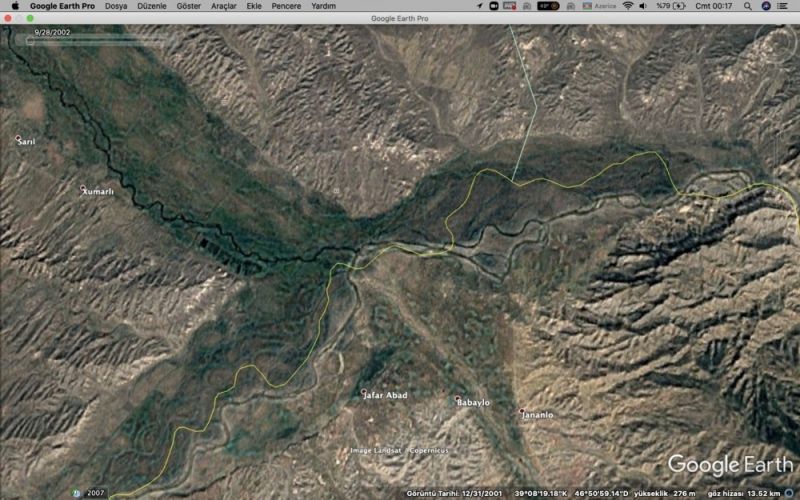
| THIS IMAGE WAS TAKEN BY GOOGLE EARTH ON DECEMBER 31, 2001.. |
But then the images changed rapidly. We see from Google's image on December 31, 2006, that Iran started construction in the area without the agreement with Azerbaijan and even completed the construction of concrete walls.
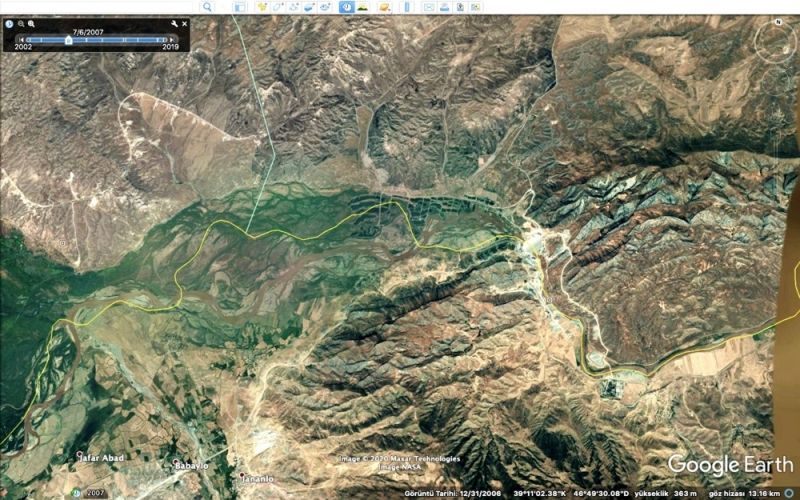
Our next image was recorded in late 2008, It is clear from the images 2 years later that Iran has completed the construction of the reservoir of the Khodaafarin hydroelectric power plant, has constructed a dam in front of the Araz River, filled the reservoir fully with water and completed the process by flooding more than 1,300 hectares of Azerbaijan by the approximate calculation from this picture.
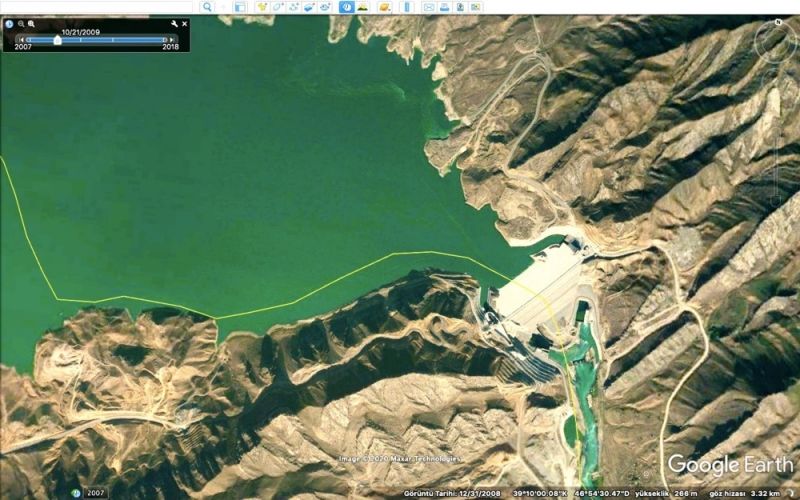
This image was recorded by Google on December 31, 2008.
This move by Iran, its alone use of the territories of which the parties have the right to joint use, caused Azerbaijan to bring forward the right to seek justice under international law. Considering the UN[2], EU, and US sanctions against Iran in 2006-2008, this could be a reason (or an excuse) to take legal action against Iran.
To refresh the memory, I would like to recall that this was the period when Eynulla Fatullayev published an article on March 30, 2007, entitled “Aliyevs go to war” (in Russian: Алиевы идут на войну”) in Real Azerbaijan (in Russian: Реальный Азербайджан). Since he wrote in the article that "if the United States attacks Iran, Iran will target Azerbaijan's strategic points" and counted certain places, on May 6, 2007, the Investigation Department of the Ministry of National Security (MNS) launched a criminal investigation into the publication of the article under Article 214.1 of the Criminal Code (terrorism or threat of committing terrorism) for the propaganda of terrorism. On October 30, 2007, the Court on Grave Crimes found Fatullayev guilty of all charges and sentenced him to eight years in prison for the threat of committing terrorism. (Note: On April 22, 2010, the ECtHR ruled that Fatullayev's rights had been violated.[3])
My purpose in emphasizing this is to clearly show the relations of that period and the targeting of Iran. In other words, Iran had not ruled out that it would experience additional problems due to its unilateral action and using the territories without the permission of our country, and accordingly, in case of Azerbaijan's raising this issue seriously, at a time[4] when Iran had already been clamped[5] internationally. Therefore, it was necessary to persuade Azerbaijan to legalize the project, which was completed and even used as shown in the picture. Although once upon a time, Azerbaijan did not agree to the construction.
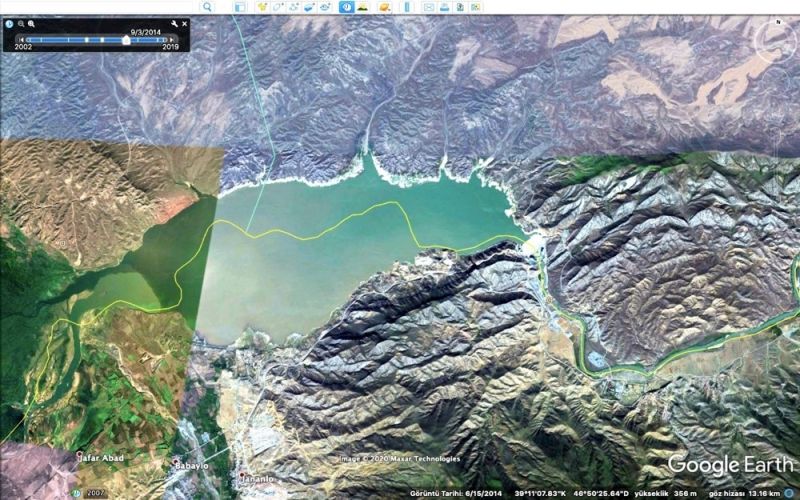
This image was recorded by Google on June 15, 2014
Just, agreement on paper…
The opportunity that Iran needs came in 2016. Something happened in February 2016 and Iran, which had not started any construction in the area until the death of Heydar Aliyev, who strongly objected to Iran and did not allow the construction, persuaded the Azerbaijani side and included it to the process just on paper in order to make the project, which was started, completed, and used for many years without respecting the position of Azerbaijan, problem-free in terms of international law
On February 23, 2016, by the Order[6] of President Ilham Aliyev № 1803, the Minister of Economy, Shahin Abdulla oglu Mustafayev, was authorized to sign an Agreement between the Government of the Republic of Azerbaijan and the Government of the Islamic Republic of Iran on cooperation in the field of continuation of construction, operation, use of energy and water resources of Khodaafarin and Maiden’s Tower hydro-junctions and hydroelectric power stations on the Araz River. The Agreement was signed on the same day, and on June 14, 2016, the Agreement was formalized by a vote of 99 in the Milli Majlis (against and without neutrality). The Agreement was signed on the same day, and on June 14, 2016, the Agreement was formalized by voting of 99 people in favor (without against and without neutral) in the Milli Majlis.[7]
What happened in 2016 that changed Azerbaijan's position?
During the discussion of this issue in the parliament, after the presentation of the Speaker, no MP expressed these images, and at the same time, no one asked what had changed after the nonconsenting of Heydar Aliyev in 1998? Why do we formalize the project of Iran, which, did not respect the position of Azerbaijan and its government and arbitrarily started and finished the construction despite the lack of consent? Why do we become a partner in their project, which was constructed unilaterally without showing us respect, and its costs? Why do we have the cost of our lands they flooded without our consent compensated with the costs of that construction?
I questioned above, "What happened in 2016 that changed Azerbaijan's position?" Perhaps the answer to this question should be sought in the decision[8] to hold a referendum on constitutional changes in Azerbaijan in 2016, one month after the formalization of this Agreement, and in the emergence of a new structure in government.
Today, the latest images of the area clearly show that this project does not serve our interests. Our ruined villages in front of the Khodaafarin Bridge, in fact, say everything.
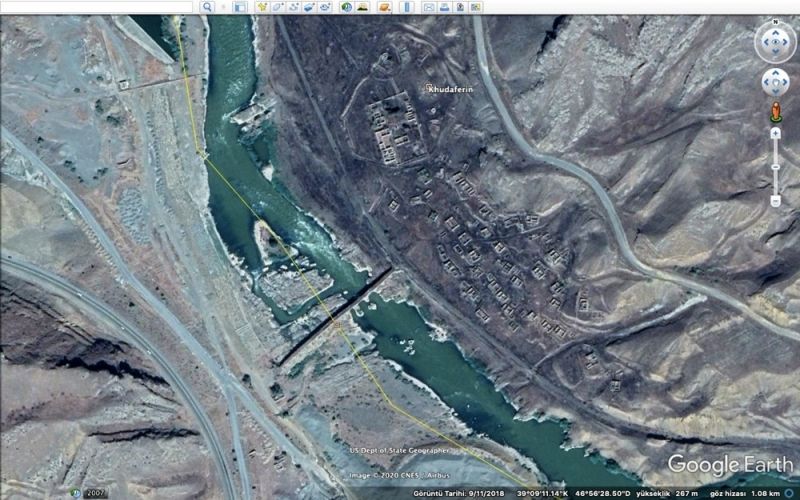
[1] http://www.e-qanun.az/framework/33288
[2] https://undocs.org/S/RES/1747(2007)
[3] http://academy-justice.gov.az/aihm/19.pdf
[4] https://undocs.org/S/RES/1747(2007)
[5] https://undocs.org/S/RES/1803(2008)
[6] http://www.e-qanun.az/framework/33451























Leave a review